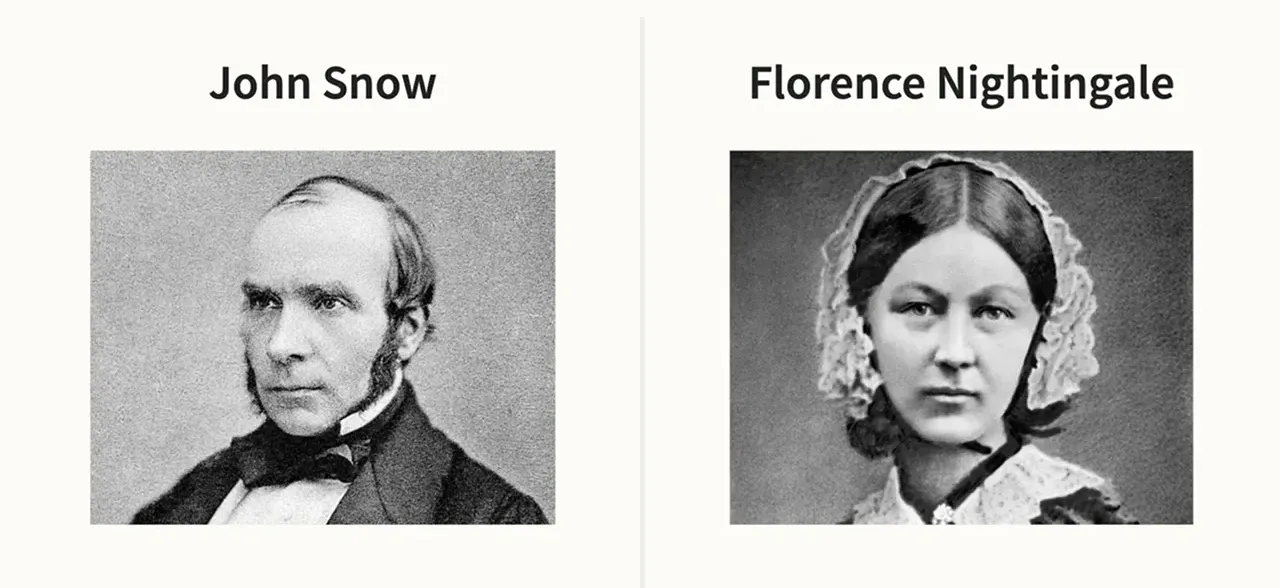Exploring the past of data visualization, in the healthcare sector gives us a base to understand how it is used today for purposes in modern times. John Snow and Florence Nightinale stand out as figures in this evolution as their work has paved the way for the data focused approaches, in medical field practices.

John Snow: The Father of Epidemiology
John Snow is recognized as a figure, in epidemiology for his significant contributions during the cholera epidemic in London in 1854. By mapping out the locations of cholera related deaths and identifying a clustering near a water pump on Broad Street Snow demonstrated the valuable impact of visual data analysis in addressing public health emergencies.
His innovative approach of removing the handle from the pump following this insight ultimately played a role, in reducing the spread of cholera.
Snows creative application of mapping not underscored the significance of ensuring access, to drinking water but also showcased how visualizing data can have a profound impact on improving public health outcomes illustrating the enduring influence of data visualization, in tackling pressing healthcare challenges.
Florence Nightingale: The Pioneer of Nursing and Statistics
Florence Nightingale wasn’t a nurse but a social reformer and statistician who lived between 1820 and 1910.Her examination of death rates, among British troops in the Crimean War stands out as one of her significant accomplishments.Nightingale innovatively brought forth the polar area diagram or the Nightingale rose diagram to visually portray the reasons for mortality.
This visual representation showed that infectious diseases caused fatalities than injuries, from battles stressing the importance of better hygiene conditions.
Nightingales contributions greatly impacted the transformation of healthcare practices and hygiene standards; they played a role, in shaping public health policies well.
The Historical Context of Data Visualization in Healthcare
The impact of John Snow and Florence Nightinngale showcases the enduring connection, between visualizing data and promoting public health initiatives over time Their strategies have motivated healthcare practitioners for years to adopt evidence based methods to address health issues This historical background emphasizes the significance of visual data analysis, in healthcare settings leading to present day advancements
Modern Applications of Data Visualization
Nowadays data visualization is significantly important, in areas of healthcare ranging from treatment to analyzing public health data.The progress, in technology has empowered healthcare experts to utilize volumes of data and convert it into insights.
Improving Patient Care
Medical professionals can use data visualization tools to keep track of patients well being in time efficiently by analyzing patient data to spot patterns and potential risks promptly for better patient care and proactive healthcare management.
Public Health Monitoring
Health organizations use data visualization to monitor disease outbreaks and track health trends in the population effectively.Rooted in dashboards and maps that offer, up to date information on the progression of diseases.These tools play a role in responding to health emergencies, like pandemics.
Operational Efficiency
Healthcare institutions make use of data visualization to enhance efficiency and lower expenses. Through examining how resources are utilized and the flow of patients, within hospitals organizations can pinpoint inefficiencies. Introduce measures to enhance the delivery of services.
Tools for visualization aid stakeholders in comprehending data, which in turn leads to informed decision making and enhancements, in operations.
The Future of Data Visualization in Healthcare
The development of data visualization, in the healthcare sector is ongoing. Shows no signs of slowing down soon as technology progresses further into the future.The possibilities for uses in the industry are extensive with advancements in artificial intelligence (AI) machine learning combined with data visualization offering exciting prospects, for improving predictive analytics and customized healthcare solutions.
Challenges Ahead
In the healthcare sector there are still obstacles to overcome in deploying data visualization solutions despite the advancements made far in this area of technology adoption and implementation.
Key hurdles include maintaining data privacy standards as integrating various data sources seamlessly while also ensuring the accuracy and reliability of the data being visualized. All crucial factors to maximize the usefulness and functionality of visualization tools, in healthcare settings.
Conclusion
The history lessons, from individuals such as John Snow and Florence Nightingle highlight the significance of data representation, in the field of healthcare.It is crucial to adopt creative visualization methods to address obstacles and enhance patient results.These trailblazers influence motivates the progression of data centric healthcare strategies.


